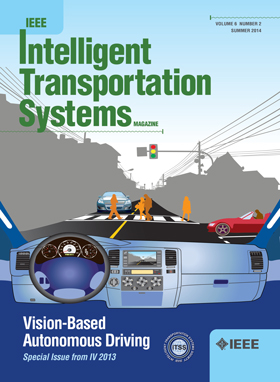基于RSS测量的城市路网轨迹映射匹配
IF 7.9
1区 工程技术
Q1 ENGINEERING, CIVIL
IEEE Transactions on Intelligent Transportation Systems
Pub Date : 2025-02-27
DOI:10.1109/TITS.2025.3544399
引用次数: 0
摘要
无线通信网络的广泛部署推动了利用信号通道解决现实世界挑战的重大进展,例如车辆轨迹重建(VTR)、无人机轨迹规划和网络优化。现有方法主要利用到达时间差(TDoA)测量进行车辆定位。然而,这些方法需要能够破译通信协议的专用解码接收器,导致应用成本增加。接收信号强度(RSS)是一种无线信号强度测量方法,可由任何标准通信设备记录,因此基于 RSS 的 VTR 具有成本效益。然而,RSS 固有的噪声和零星特性给准确重建车辆轨迹带来了巨大挑战。本文旨在利用 RSS 测量重建道路网络中的车辆轨迹。我们对轨迹进行了限制,使其符合信号传播规则和车辆移动限制,从而减轻了 RSS 数据的噪声和零星性对轨迹重建准确性的影响。主要的挑战是在复杂的道路网络中导航时,如何利用噪声和零星 RSS 数据中潜在的时空相关性。为了克服这些挑战,我们开发了一种基于隐马尔可夫模型(HMM)的 RSS 嵌入(HRE)技术,该技术利用交替优化来搜索基于 RSS 测量的车辆轨迹。该模型可有效捕捉 RSS 测量值之间的时空关系,而道路图模型则可确保符合网络路径。此外,我们还引入了最大速度受限的粗略轨迹估计(MSR)方法,以有效指导拟议的交替优化程序,确保拟议的 HRE 方法快速收敛到有利的局部解。利用中国成都和深圳 5G NR 网络的真实 RSS 测量结果对所提出的方法进行了验证。实验结果表明,即使在 RSS 数据有限的情况下,所提出的方法也明显优于最先进的方法。本文章由计算机程序翻译,如有差异,请以英文原文为准。
Trajectory Map-Matching in Urban Road Networks Based on RSS Measurements
The widespread deployment of wireless communication networks has catalyzed significant advancements in utilizing signal channs to address real-world challenges, such as vehicle trajectory reconstruction (VTR), drone trajectory planning, and network optimization. Existing methods primarily utilize time-difference-of-arrival (TDoA) measurements for vehicle localization. However, these methods require specialized decoding receivers capable of deciphering communication protocols, leading to increased application costs. received signal strength (RSS), a measure of wireless signal strength, can be recorded by any standard communication device, thus allowing RSS-based VTR to benefit from cost-effectiveness. Nevertheless, the inherently noisy and sporadic nature of RSS poses significant challenges for accurately reconstructing vehicle trajectories. This paper aims to utilize RSS measurements to reconstruct vehicle trajectories within a road network. We constrain the trajectories to comply with signal propagation rules and vehicle mobility constraints, thereby mitigating the impact of the noisy and sporadic nature of RSS data on the accuracy of trajectory reconstruction. The primary challenge involves exploiting latent spatial-temporal correlations within the noisy and sporadic RSS data while navigating the complex road network. To overcome these challenges, we develop an hidden Markov model (HMM)-based RSS embedding (HRE) technique that utilizes alternating optimization to search for the vehicle trajectory based on RSS measurements. This model effectively captures the spatial-temporal relationships among RSS measurements, while a road graph model ensures compliance with network pathways. Additionally, we introduce a maximum speed-constrained rough trajectory estimation (MSR) method to effectively guide the proposed alternating optimization procedure, ensuring that the proposed HRE method rapidly converges to a favorable local solution. The proposed method is validated using real RSS measurements from 5G NR networks in Chengdu and Shenzhen, China. The experimental results demonstrate that the proposed approach significantly outperforms state-of-the-art methods, even with limited RSS data.
求助全文
通过发布文献求助,成功后即可免费获取论文全文。
去求助
来源期刊

IEEE Transactions on Intelligent Transportation Systems
工程技术-工程:电子与电气
CiteScore
14.80
自引率
12.90%
发文量
1872
审稿时长
7.5 months
期刊介绍:
The theoretical, experimental and operational aspects of electrical and electronics engineering and information technologies as applied to Intelligent Transportation Systems (ITS). Intelligent Transportation Systems are defined as those systems utilizing synergistic technologies and systems engineering concepts to develop and improve transportation systems of all kinds. The scope of this interdisciplinary activity includes the promotion, consolidation and coordination of ITS technical activities among IEEE entities, and providing a focus for cooperative activities, both internally and externally.
 求助内容:
求助内容: 应助结果提醒方式:
应助结果提醒方式:


